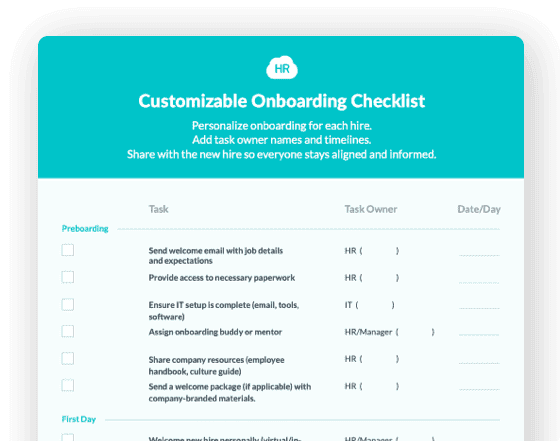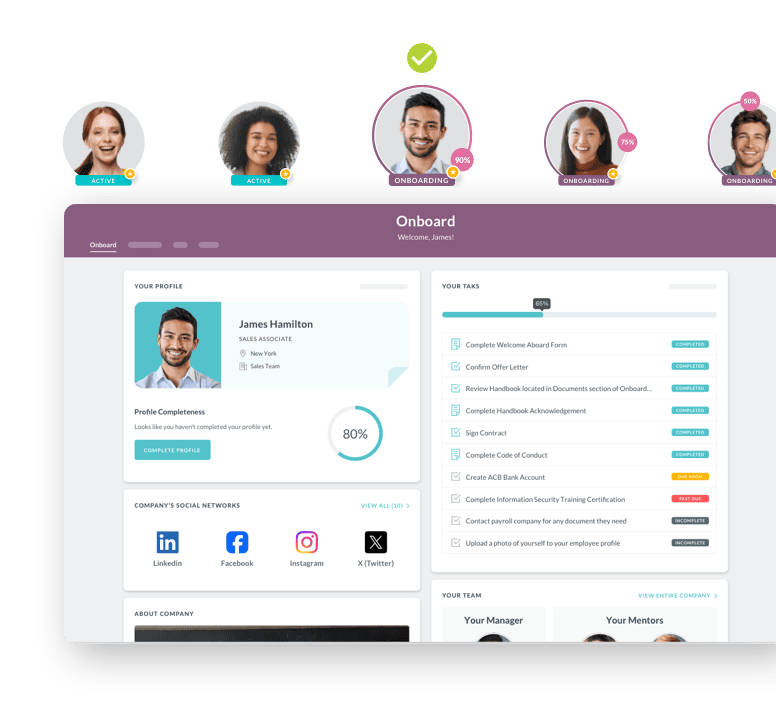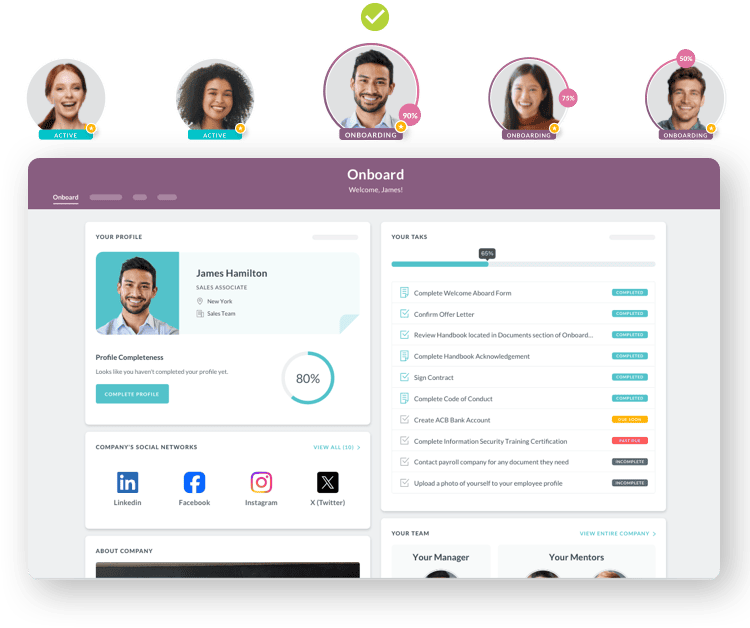Qualifying Life Event: Spouse New Job
- Key Elements of Spousal Job Change as a Qualifying Life Event
- Comparing Qualifying Life Events for Spousal Employment Changes
- Best Practices for Managing Spouse's New Job as a Qualifying Event
- Pitfalls to Avoid When Handling Spousal Employment Qualifying Events
- Industry Applications of Spousal Employment Qualifying Events
- Implementation Plan for Managing Spousal Job Change Events
- Future Trends in Spousal Employment and Benefits Administration

 Cut onboarding time
by 60%—here's the
Ultimate Checklist
that helped do it.
Cut onboarding time
by 60%—here's the
Ultimate Checklist
that helped do it.

When your employee's spouse starts a new job, it creates more than just a household celebration. It triggers a significant opportunity for your workforce to adjust their health insurance and benefits coverage outside the typical enrollment period. This type of change, known as a qualifying life event related to spousal employment, directly affects how you manage benefits administration and support your team through important life transitions.
A spouse's new job matters because it often comes with changes to health insurance coverage. Maybe your employee has been covering their spouse under your company plan, but now the spouse has access to better coverage through their new employer. Or perhaps your employee wasn't enrolled in your benefits before because they relied on spousal coverage that no longer makes sense. Either way, this change gives both you and your employee flexibility to make smart decisions about coverage that work for everyone involved.
Understanding how to handle these situations properly protects your business from compliance issues while showing your team you care about their wellbeing during major life changes. When you manage benefits administration effectively, you reduce confusion, prevent coverage gaps, and help employees make informed choices about their health insurance options. This isn't just about following rules, it's about building trust with your workforce when they need support the most.
Key Elements of Spousal Job Change as a Qualifying Life Event
Before diving into the details, it helps to understand what makes a spouse's new job a qualifying event and when it actually triggers the opportunity for changes. Not every employment situation counts the same way.
-
A spouse gaining new employer-sponsored health insurance coverage creates a qualifying event that allows your employee to drop spousal coverage from your plan, helping reduce their payroll deductions and potentially freeing up budget for other benefits.
-
When a spouse loses their job or quits, your employee can add that spouse to your company plan within a limited window, typically 30 to 60 days from the job loss date.
-
The qualifying event begins on the actual employment start date or coverage loss date, not when the employee tells you about it, which means timing matters significantly for documentation purposes.
-
Your employee must provide proper documentation such as verification letters from the new employer, coverage start dates, or termination notices to validate the qualifying life event claim.
-
Changes made during a special enrollment period triggered by spousal employment typically take effect on the first day of the month following the request, though some circumstances allow for retroactive coverage.
Comparing Qualifying Life Events for Spousal Employment Changes
|
Event Type |
Common Scenarios |
Documentation Needed |
Special Enrollment Window |
Coverage Impact |
|
Spouse Gains New Job |
New employer offers better benefits; Spouse transitions from unemployment to employment; Spouse moves from part-time to full-time with benefits |
Letter from new employer showing coverage start date; Benefits summary from new employer |
30-60 days from coverage effective date |
Employee can drop spouse from their plan or adjust coverage level |
|
Spouse Loses Job |
Termination, resignation, furlough, or layoff resulting in coverage loss |
Termination letter; COBRA notice; Certificate of creditable coverage showing end date |
30-60 days from coverage end date |
Employee can add spouse to their plan or increase coverage |
|
Spouse Changes Employment Status |
Reduction in hours making spouse ineligible for benefits; Change from benefits-eligible to ineligible position |
Letter from employer confirming change in status and benefits eligibility |
30-60 days from eligibility change date |
May add, drop, or modify coverage based on new circumstances |
|
Relocation for Spouse's Job |
Spouse's new job requires geographic move outside current plan's service area |
Proof of relocation; New employer offer letter showing location; Lease or mortgage documents |
30-60 days from move date |
May require plan change if moving outside network coverage area |
Best Practices for Managing Spouse's New Job as a Qualifying Event
Handling qualifying life events smoothly requires clear processes and consistent communication. When you get this right, you prevent costly mistakes and keep your employees satisfied with their benefits experience.
First, establish a clear communication protocol that educates employees about qualifying events before they happen. Include information about spousal employment changes in your onboarding materials and send annual reminders during open enrollment season. Many employees don't realize their spouse getting a new job creates an opportunity for coverage changes, so proactive education saves confusion later.
Create a simple submission process through your employee portal where staff can upload documentation and request changes electronically. Digital systems reduce paperwork delays and create automatic audit trails that protect you during compliance reviews. When everything lives in one place, you spend less time chasing down forms and more time focusing on strategic HR priorities.
Document every qualifying event thoroughly in your HRIS system with dates, supporting evidence, and the specific changes made. This protects your organization if questions arise months or years later about why certain coverage modifications occurred outside open enrollment periods. Good documentation also helps you identify patterns in how often certain qualifying events occur, which can inform future benefits planning decisions.
Train your HR team and managers to respond quickly when employees report spousal employment changes. The window for making changes is short, usually 30 to 60 days depending on your plan documents, and missing deadlines means employees may have to wait until the next open enrollment period. Quick responses also demonstrate that you value employee needs and take their benefits seriously.
Partner with your benefits broker or insurance carrier to verify you're interpreting qualifying event rules correctly. According to SHRM guidance, different types of plans may have slightly different rules about what changes are permitted and when they take effect. Regular check-ins with benefits experts ensure you stay compliant as regulations evolve.
Review your plan documents annually to confirm your qualifying event policies align with current regulations and match what you're communicating to employees. Outdated policies create confusion and potential compliance issues. Make updates whenever insurance carriers change terms or new legislation affects benefit administration requirements, keeping all your HR compliance documentation current and accurate.


Pitfalls to Avoid When Handling Spousal Employment Qualifying Events
Even experienced HR teams make mistakes with qualifying life events. These errors can cost your organization money, create legal exposure, and damage employee trust.
One common mistake is assuming all job changes count as qualifying events. The spouse simply getting a new job doesn't automatically trigger a qualifying event unless there's an actual change in insurance coverage eligibility or availability. If the spouse moves from one job without benefits to another job without benefits, no qualifying event occurs. Always verify whether the employment change actually affects health insurance coverage before processing enrollment modifications.
Many organizations fail to enforce the documentation requirement strictly, accepting verbal claims about spousal employment without proper verification. This opens your company to potential fraud and makes it difficult to defend your decisions if challenged. Always require written proof such as offer letters, coverage summaries, or termination notices that clearly show the employment change and any coverage implications before allowing enrollment changes.
Missing the deadline is another frequent problem that leaves employees stuck with unwanted coverage or gaps in protection. Some HR teams don't communicate urgency effectively, allowing employees to assume they have unlimited time to make changes. Others fail to track when the qualifying event actually occurred versus when the employee reported it. The clock starts ticking on the event date, not the notification date, so clear communication about deadlines is essential from the first conversation.
Overlooking the coordination of benefits rules causes confusion when both spouses have access to employer coverage. Employees need guidance on which plan provides better coverage for their family situation and how to avoid duplicate coverage that wastes money without providing additional value. Provide objective information or decision-making tools that help employees compare options based on premiums, deductibles, networks, and out-of-pocket maximums.
Failing to update payroll deductions correctly after enrollment changes creates frustration for employees who notice incorrect amounts being withheld from their paychecks. Cross-functional coordination between benefits administration and payroll teams prevents these errors. Use integrated HRIS platforms where benefits elections automatically flow to payroll systems, reducing manual data entry and the mistakes that come with it.
Industry Applications of Spousal Employment Qualifying Events
Different industries experience spousal job changes in unique ways that affect how you approach benefits administration. Understanding these patterns helps you anticipate needs and build better support systems.
In healthcare, where many employees have spouses who also work in medical settings, spousal job changes happen frequently as professionals move between hospitals, clinics, and other healthcare organizations. A nurse whose spouse switches from a small medical practice to a large hospital system may need to evaluate whether the spouse's new comprehensive coverage makes more sense than staying on the employee's plan. Healthcare HR teams often manage multiple qualifying events monthly and need streamlined systems to handle volume efficiently without sacrificing accuracy or employee service.
Technology companies commonly see spousal employment changes when one partner moves from a startup offering limited benefits to an established tech company with robust insurance options, or vice versa. These situations require careful evaluation because both employers may offer excellent coverage, making the decision more complex. Tech HR teams benefit from providing comparison tools and access to benefits counselors who can help employees make informed choices based on their specific family health needs and financial situations.
Manufacturing organizations frequently encounter qualifying events when a spouse transitions from temporary or contract work to permanent employment with benefits, or when economic conditions lead to layoffs affecting many families in the same community simultaneously. During economic downturns, manufacturing HR departments may process dozens of qualifying events within a short period as spouses lose jobs, requiring surge capacity and clear communication to prevent employees from experiencing coverage gaps. Research from Gallup indicates that health insurance concerns significantly influence employment decisions, making responsive benefits administration critical for retention during uncertain times.
Implementation Plan for Managing Spousal Job Change Events
Creating a systematic approach to spousal employment qualifying events ensures consistency and compliance while making the process easier for everyone involved. Follow these steps to build an effective system.
Start by reviewing your current plan documents with your insurance carriers and legal counsel to clearly understand what qualifies as a valid event and what documentation you need. Different plans may have slightly different requirements, and knowing these details before an employee asks for changes prevents delays and confusion. Document your findings in a simple reference guide that HR staff can consult when questions arise.
Next, create clear written procedures that outline exactly what happens when an employee reports a spousal job change. Include who they should contact, what forms they need to complete, what documentation to provide, and what deadlines apply. Make this information easily accessible through your employee portal or benefits administration system so employees can find answers quickly without waiting for HR to respond.
Build decision-making tools or resources that help employees evaluate whether adding or dropping spousal coverage makes sense for their situation. Simple comparison worksheets that help families calculate total costs, compare deductibles and out-of-pocket maximums, and evaluate provider networks empower better choices. You're not making recommendations, but you're providing the information employees need to decide confidently.
Implement tracking systems that monitor when qualifying events are reported, when documentation is received, when changes are processed, and when coverage becomes effective. Automated reminders alert HR staff when deadlines approach or documentation is missing. This prevents things from falling through the cracks during busy periods when multiple events may be happening simultaneously.
Train managers and supervisors to recognize when employees mention spousal job changes and direct them immediately to HR or the benefits team. Many qualifying events get reported casually in conversations, and managers who understand the time-sensitive nature of these changes can help ensure employees don't miss their opportunity to make adjustments. Include qualifying event awareness in management training programs and periodic refreshers.
Establish a regular review schedule, perhaps quarterly, to analyze how well your qualifying event process is working. Track metrics like time from event to enrollment change, documentation completion rates, deadline compliance, and employee satisfaction. Use this data to identify bottlenecks and make continuous improvements to your system, keeping the process efficient as your organization and benefits offerings evolve.
Future Trends in Spousal Employment and Benefits Administration
The landscape of benefits administration continues to evolve with changing work patterns, technology advances, and shifting employee expectations. Understanding these trends helps you prepare for what's coming and position your organization to handle qualifying events more effectively.
Remote work and portable benefits are reshaping how families think about health insurance. As more people work remotely for employers located in different states, and as spouses increasingly work for different companies in different locations, the traditional model of benefits administration faces new complexities. You'll need systems that can handle multi-state compliance requirements and help employees navigate coverage when family members work for employers in different jurisdictions.
Technology platforms are making qualifying event management increasingly automated and employee-driven. Modern benefits administration systems use artificial intelligence to flag potential qualifying events based on life changes employees report in other HR systems, proactively prompting them to consider coverage adjustments. Predictive analytics can identify when qualifying events are likely to occur based on patterns in your workforce, allowing you to prepare communication campaigns in advance. These tools reduce administrative burden while improving the employee experience through personalized, timely support.
The rise of benefits marketplaces and private exchanges gives employees more flexibility in choosing coverage options, but it also increases complexity when managing qualifying events. When spouses have access to multiple plan options through their new employers, comparative decision-making becomes more challenging. Forward-thinking organizations are investing in benefits navigation services and decision support tools that help employees cut through this complexity and make choices aligned with their health needs and financial situations.
Legislative changes continue to reshape benefits requirements and what counts as a qualifying event. Stay informed about proposed regulations at both federal and state levels that could affect how you manage spousal employment changes. Building relationships with benefits consultants and industry associations helps you anticipate changes and adjust your processes before new requirements take effect, maintaining compliance without scrambling at the last minute.
The shift toward total rewards transparency means employees increasingly expect clear, comprehensive information about all their compensation elements, including how benefits compare to market standards. When a spouse gets a new job with benefits, employees want sophisticated tools to compare total compensation packages, not just base salaries. Organizations that provide this level of transparency and decision support will have a competitive advantage in attraction and retention, particularly as healthcare costs continue rising and employees seek the best value for their benefits dollars.
Keep Reading
Enterprise HR Software in 2025: Why Traditional Enterprise Platforms Fall Short and What Actually Works
Traditional enterprise human resources software systems promise comprehensive solutions
AI in Onboarding: Complete Guide for 2026
You’ve probably been hearing this multiple times a day — AI is transforming HR. But
How HR Cloud Is Shaping the Future of HR in Senior Care
At the 2025 LeadingAge Annual Meeting in Boston, one conversation is taking centerstage —
Ready to streamline your onboarding process?
Book a demo today and see how HR Cloud can help you create an exceptional experience for your new employees.

